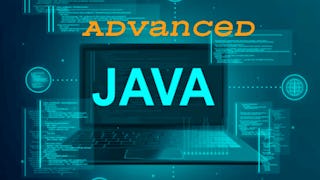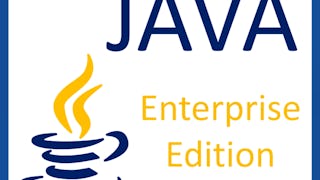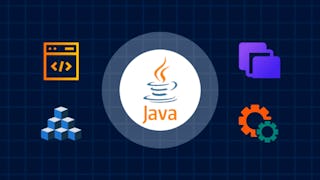This comprehensive course equips learners with the skills to design, develop, and manage dynamic web applications using Java Servlets and JDBC integration within the Java EE framework. Through a structured and hands-on approach, learners begin by exploring the core principles of servlet architecture, HTTP request handling, and server setup using Tomcat. As the course progresses, they will implement servlet lifecycle methods, configure initialization parameters, and construct scalable applications using the MVC pattern.



Expérience recommandée
Compétences que vous acquerrez
- Catégorie : Middleware
- Catégorie : Java
- Catégorie : Data Access
- Catégorie : Java Platform Enterprise Edition (J2EE)
- Catégorie : Secure Coding
- Catégorie : Authentications
- Catégorie : Web Applications
- Catégorie : Software Design Patterns
- Catégorie : Server Side
- Catégorie : Relational Databases
- Catégorie : Back-End Web Development
- Catégorie : Web Servers
- Catégorie : SQL
- Catégorie : Databases
- Catégorie : Stored Procedure
- Catégorie : Data Validation
- Catégorie : Apache Tomcat
- Catégorie : Model View Controller
- Catégorie : Application Servers
Détails à connaître

Ajouter à votre profil LinkedIn
juillet 2025
28 devoirs
Découvrez comment les employés des entreprises prestigieuses maîtrisent des compétences recherchées

Il y a 8 modules dans ce cours
This module introduces the foundational concepts of Java EE (J2EE) and the role of servlets in web applications. Learners will gain a practical understanding of servlet architecture, how to set up the environment using Tomcat, and implement basic servlet functionality through lifecycle methods and HTTP request handling. It builds the core knowledge required to develop and deploy servlet-based applications in a Java EE environment.
Inclus
8 vidéos4 devoirs
This module explores the use of servlet configuration and context objects, enabling learners to manage shared application data and initialization parameters. The lessons focus on differentiating between ServletConfig and ServletContext, understanding their practical use cases, and configuring servlet behavior through load-on-startup mechanisms. This sets the stage for building efficient, state-aware web applications.
Inclus
5 vidéos3 devoirs
This module introduces the Model-View-Controller (MVC) architectural pattern within the context of Java Servlets. Learners will explore how to separate concerns in web application development, implement request dispatching using RequestDispatcher, and understand how forwarding and redirection operate within servlet-based architectures. Through practical code examples and guided explanation, this module emphasizes clean design and control flow in servlet applications.
Inclus
10 vidéos4 devoirs
This module focuses on preserving user data across multiple interactions with a web application. Learners will explore the core techniques of session tracking in Java Servlets, including cookies, hidden fields, and URL rewriting. The lessons provide hands-on exposure to maintaining state in stateless HTTP environments, helping learners build more interactive and user-aware applications.
Inclus
7 vidéos4 devoirs
This module extends session tracking by focusing on HTTP session objects and cookie-based authentication mechanisms. Learners will learn how to implement login/logout functionality using both session and cookie strategies. By building end-to-end examples, this module helps consolidate skills in user session control, secure access, and lifecycle handling of web interactions.
Inclus
7 vidéos3 devoirs
This module introduces learners to database fundamentals and SQL operations in the context of Java web development. It begins with a foundational overview of relational databases and continues through practical SQL syntax, covering commands for data manipulation, definition, and constraint enforcement. Learners will understand how to prepare data environments for backend integration with servlet-based applications.
Inclus
14 vidéos4 devoirs
This module bridges Java web applications with backend databases using JDBC (Java Database Connectivity). Learners will explore how to establish connections, perform CRUD operations, and securely interact with database systems through servlets. The lessons emphasize JDBC classes and interfaces, as well as best practices for real-world data handling.
Inclus
6 vidéos3 devoirs
Inclus
6 vidéos3 devoirs
Obtenez un certificat professionnel
Ajoutez ce titre à votre profil LinkedIn, à votre curriculum vitae ou à votre CV. Partagez-le sur les médias sociaux et dans votre évaluation des performances.
En savoir plus sur Software Development
 Statut : Prévisualisation
Statut : PrévisualisationLearnKartS
 Statut : Essai gratuit
Statut : Essai gratuitLearnQuest
 Statut : Essai gratuit
Statut : Essai gratuitBoard Infinity
 Statut : Essai gratuit
Statut : Essai gratuit
Pour quelles raisons les étudiants sur Coursera nous choisissent-ils pour leur carrière ?





Ouvrez de nouvelles portes avec Coursera Plus
Accès illimité à 10,000+ cours de niveau international, projets pratiques et programmes de certification prêts à l'emploi - tous inclus dans votre abonnement.
Faites progresser votre carrière avec un diplôme en ligne
Obtenez un diplôme auprès d’universités de renommée mondiale - 100 % en ligne
Rejoignez plus de 3 400 entreprises mondiales qui ont choisi Coursera pour les affaires
Améliorez les compétences de vos employés pour exceller dans l’économie numérique
Foire Aux Questions
Access to lectures and assignments depends on your type of enrollment. If you take a course in audit mode, you will be able to see most course materials for free. To access graded assignments and to earn a Certificate, you will need to purchase the Certificate experience, during or after your audit. If you don't see the audit option:
The course may not offer an audit option. You can try a Free Trial instead, or apply for Financial Aid.
The course may offer 'Full Course, No Certificate' instead. This option lets you see all course materials, submit required assessments, and get a final grade. This also means that you will not be able to purchase a Certificate experience.
When you purchase a Certificate you get access to all course materials, including graded assignments. Upon completing the course, your electronic Certificate will be added to your Accomplishments page - from there, you can print your Certificate or add it to your LinkedIn profile. If you only want to read and view the course content, you can audit the course for free.
You will be eligible for a full refund until two weeks after your payment date, or (for courses that have just launched) until two weeks after the first session of the course begins, whichever is later. You cannot receive a refund once you’ve earned a Course Certificate, even if you complete the course within the two-week refund period. See our full refund policy.
Plus de questions
Aide financière disponible,



